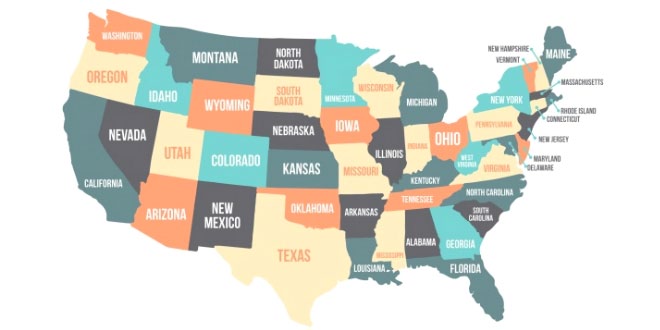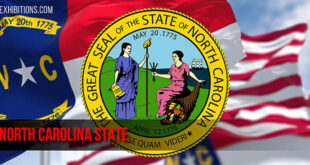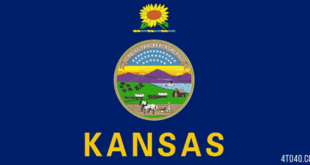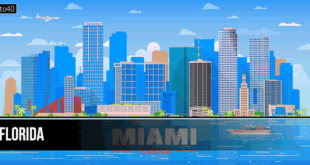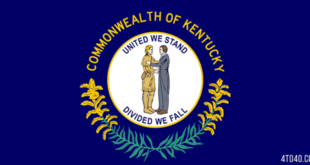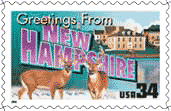
The state derives its name from the county of Hampshire, England, where Capt. John Mason, the founder and first proprietor of the colony, was governor of the English city of Portsmouth, for which New Hampshire’s only port city is named.
New Hampshire State: Land & Resources
Topographically, the state’s most conspicuous feature is the WHITE MOUNTAINS, whose 86 peaks in the north central part of the state are the highest mountain range in the northeastern United States. Eleven peaks in Coos County, five more than 1.6 km (1 mi) above sea level, form the Presidential Range, which culminates in Mount Washington at 1,917 m (6,288 ft; see WASHINGTON, MOUNT).
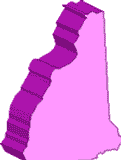
Immediately north of the White Mountain National Forest lies the high land of New Hampshire’s North Country, coinciding with most of Coos County. Along the Vermont border, the Connecticut River valley provides New Hampshire’s best farming country. In the southeastern corner of the state, New Hampshire’s Eastern Slope descends gradually to the sea. The brief New Hampshire coastline consists of sandy beaches in addition to Portsmouth Harbor at the mouth of the Piscataqua River.
Rivers and Lakes
The CONNECTICUT RIVER rises from the three Connecticut Lakes in Coos County and drains the entire state west of the north-south divide, which runs the length of the state. East of the divide, two northern systems–the Androscoggin and the Saco–flow into Maine. Umbagog Lake straddles the Maine border, furnishing the headwaters of the Androscoggin River. The Piscataqua drains the Eastern Slope. Just to the south of the White Mountain area the Lakes district forms a wide belt across the middle section of the state. The largest of these lakes is Lake WINNIPESAUKEE, source of the Merrimack River, which drains the south central portion of the state into the Atlantic.
Climate
Temperatures generally run several degrees cooler in the northern highlands than in the southern half of the state. Mean monthly temperatures for January range from -12 deg C (10 deg F) in the extreme north to -6 deg C (21 deg F) in the south. Mean monthly temperatures for July range from 16 deg C (61 deg F) in the north to about 21 deg C (70 deg F) in the south. Average yearly precipitation, aside from the 1,930 mm (76 in) atop Mount Washington, ranges from Hanover’s 914 mm (36 in) to Durham’s 1,067 mm (42 in). Much falls as snow.
Historic Sites and Recreation Areas
The home of the sculptor Augustus SAINT-GAUDENS at Cornish has been made a National Historic Site. There are many restored colonial homes, and Fort Constitution at New Castle has been preserved. Many state parks and forest preserves supplement the White Mountain National Forest. Winter sports are increasingly important, with a number of major commercial ski areas throughout the state.
Tourism
Tourism is now the second most important sector in New Hampshire’s economy. Among the state’s major tourist attractions are the White Mountains and Lake Winnipesaukee. Skiing and water sports are activities that draw many visitors to the state each year. New Hampshire also has a number of state parks.
New Hampshire State: History
Recent archaeological discoveries suggest the presence of human life in the area about 10,000 years ago. At the time of the first English settlements in 1623, there probably were about 4,000 Indians within the present area of the state, more than half in the various tribes of the PENNACOOK Confederacy in the Connecticut and Merrimack valleys and the seacoast area. The rest, in the eastern White Mountains and the Saco Valley, were on the western edge of the Sokoki Confederacy and merged with the ABNAKIS of Maine. The Pennacooks patronized English trading stations on the Piscataqua and, under the influence of their friendly chief, Passaconaway, negotiated sales of land (which were misunderstood on both sides) as the settlements moved inland. Friendly relations ceased at the time of KING PHILIP’s WAR (1675-76), and in 1676 most of the Pennacooks moved to Canada.
Colonial Period
English fishing and trading settlements began (1623) at Odiorne’s Point–near the mouth of the Piscataqua–and at Dover Point, 13 km (8 mi) up the river. In 1629 the original proprietors of the whole area between the Merrimack and Kennebec rivers, Sir Ferdinand Gorges and Captain John MASON, divided the area between them, Mason taking the area south of the Piscataqua, which he called New Hampshire. From 1643 to 1679, and again from 1690 to 1692, the New Hampshire settlements came under the jurisdiction of Massachusetts, and from 1692 to 1741, New Hampshire shared a royal governor with Massachusetts.
The decisive change in the importance and prospective fortunes of the province came in 1741 with the settlement of the long-disputed boundary with Massachusetts in New Hampshire’s favor and the appointment of Benning Wentworth as governor. A dispute with New York over the area west of the Connecticut River, the so-called New Hampshire Grants (present-day Vermont), was temporarily resolved in 1764. Benning Wentworth was succeeded (1767) by his nephew, John Wentworth. The latter’s administration began auspiciously with a series of successful moves to bind Portsmouth and the seacoast more closely to the developing interior, but the Revolutionary crisis proved to be a stronger force than was the young governor’s popularity. In the first overtly hostile act of the American Revolution, an armed mob stormed the fort in Portsmouth Harbor in December 1774, seized arms and powder, and distributed them among several inland towns, some of whose militiamen subsequently used them in the Battle of Bunker Hill. Wentworth left the province on a British warship in June 1775. The following year New Hampshire adopted its own constitution and was, therefore, the first colony to become wholly independent of Great Britain. In 1788, New Hampshire became the ninth state to ratify the U.S. Constitution.
Economic Development
During the early 17th century the economic life of New Hampshire was based on fishing and the exploitation of the rich native timber resources. Shipbuilding soon emerged as the leading industry and flourished throughout the 18th and 19th centuries. During the 18th century, as settlers pushed into the interior, agriculture on family farms began to rival Portsmouth-based commerce and shipbuilding as the chief economic activity of the province. The relocation of the state capital from Portsmouth to Concord in 1808 signified not only the end of the dominance of New Hampshire politics by the commercial interests of Portsmouth and Exeter but also that the center of population had moved inland.
The primacy of farming was short-lived, however, for as early as 1810 water-powered textile manufacturing arrived in New Hampshire with the founding of the Amoskeag Cotton and Woolen Manufacturing Company on the Merrimack River at the site of Manchester. Many other textile mills were soon constructed throughout most of the state.
The coming of the railroad in the late 1830s also contributed to the agricultural decline, for now farm goods produced in the fertile Midwest could reach Boston and New York markets and New England mill towns more abundantly and cheaply than those grown on marginal farmlands closer to home. Nothing documents more dramatically the decline of farming in New Hampshire than both the widespread repossession of once-cleared land by the forest and the many miles of stone walls that remain to mark abandoned fields and pastures.
The textile industry reached its peak between 1910 and 1920 and then began a long decline, primarily because of competition from the South. Large-scale shoe manufacturing, which appeared after the Civil War, has also declined but not to the same extent. Since World War II, industries attracted by an underutilized labor force, low land costs (until recently), low taxes and few regulations, and New Hampshire’s proximity to the large northeastern market have moved in to take the place of the departed woolen and cotton mills–often occupying the same buildings. An industrial group increasingly important to the state is the high-technology sector.
New Hampshire is trying to plan for a future that must balance a grave concern for continuing the quality of life to which most New Hampshire people are attached with strong pressures for further economic development.
New Hampshire State: Land
- Area: 24,219 sq km (9,351 sq mi); rank: 46th.
- Capital: Concord (1990 pop., 36,006).
- Largest city: Manchester (1990 pop., 99,567).
- Counties: 10.
- Elevations: highest–1,917 m (6,288 ft), at Mount Washington; lowest–sea level, at the Atlantic coast.
 Kids Portal For Parents India Kids Network
Kids Portal For Parents India Kids Network
